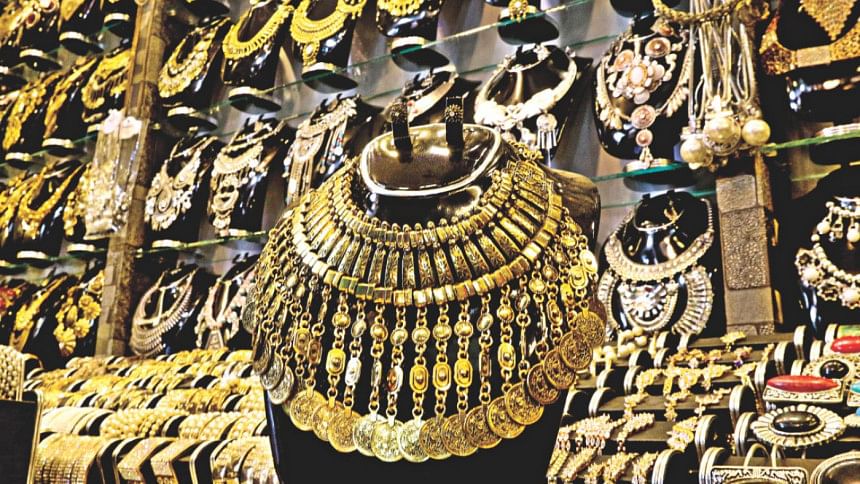The village artisans of Savar show the way

The silver or copper jewellery you picked to go with your dress was not made at the shop you bought it from. It was probably handcrafted miles away in Savar on the outskirts of the capital.
One village where this sort of intricate crafting is done is Bhakurta. Hundreds of people -- men, women, young and old -- meticulously create the foundation of ornaments every day from silver and copper.
If you pay a visit to the village, you will see some people are using fire to melt the metal, some making strings while some are piecing together designs to make ornaments.
These artisans complete 95 percent of the ornaments before those are shipped to the stores where sparkling stones and colours are added and finishing touches are given.
The jewellery-making business has made the village renowned.
“Our jewellery are not only catering to the demands in Bangladesh; they also go to Italy, Middle East and India,” said Dulal Rajbangshi, general secretary of Bhakurta Bazar Gold Silver and Imitation Merchants Cooperative Samity.
Opu Das is another jeweller. He and his brother inherited the family business of making anklets from silver. The 36-year-old himself has been in the trade for the last 15 years.
Chaity Jewellers, run by Opu, employs seven artisans who make jewellery from silver and copper. On an average, they make 300 pairs of anklets a month to fill orders from stores in the capital's Tantibazar, the jewellers' hub in the country.
The village's expertise in jewellery-making dates back to 1980s when most male members used to work for jewellery shops in Tantibazar.
But when finished gold items started to flood the market in the 1990s, their demand fell.
Some of them returned to their village homes and began making jewellery from silver. They were able to make a living from the trade between 1995 and 2010. Again the silver jewellery market faced a downturn.
This was the time when the village artisans started to look for an alternative, as this was the only trade they knew.
They found copper as an alternative to silver. They used the designs of gold and silver jewellery to create a market.
Now there are about 100 shops in Bhakurta Bazar and at least 50 shops each in adjacent Solar Market and Bottola Bazar, Dulal said.
In total, there are 500 shops and households involved in the trade, providing livelihood to at least 2,500 families in Bhakurta and neighbouring villages.
“When we started producing jewellery from copper, people doubted whether the jewellery will sell. But the demand for our jewellery is good,” he told The Daily Star on June 23.
Actual combined sales figures are hard to come by. Dulal puts the average daily sales at Tk 5 lakh and it goes up during the peak season in the winter. The annual sales might come to Tk 20 crore.
Sales also go up ahead of Eid festivals, particularly in Eid-ul-Fitr, according to Dulal.
Bhakurta's artisans have not abandoned silver completely -- about 75 percent of jewellery is made up of copper and the rest from silver and gold.
Initially, some craftsmen used to import raw materials and chemicals from India. Now those are locally available.
The artisans start working around 8:00am and continue until midnight, but the wage is very low, said 45-year-old Dulal.
Opu earns Tk 100 a bhori as making charge while his artisans from the village get Tk 40 a bhori.
Women are a large part of the business. Jewellers say there are jobs that male artisans are not interested in because of low return. These jobs are left to the village women who prefer to work in their leisure time to supplement the income of their families.
One of them is Shoma Rani. These correspondents found her sitting on the stairs of her rented house, meticulously making small coiled copper thread to be used in necklaces.
She said she could make one kg of copper thread a day, which earned her Tk 400.
“I do this whenever I get time as my income can give my two children better food, clothes and education,” said Shoma whose husband is also an artisan.
Her two daughters -- Sathi Akhtar and Dipti Rani Sarker -- were sitting with her. Sathi, 12, studies in class-VI at a school in the village and Dipti, aged 14, is a student of class-VIII in the same school. Sathi makes copper threads while Dipti puts beads on necklaces and other jewellery.
Dipti says she has learnt it from her mother and aunt who are also involved in jewellery making.
Hindu families used to dominate the trade in the past. But now many Muslims have joined in. At present, 95 percent Hindu population of the village and 50 percent Muslims are involved in the trade, according to Dulal.
Thirty-year-old Ali Asgar has been in the business in Bhakurta Bazar for more than a decade. He runs a shop of raw materials and chemicals. He also has 30 artisans working for him from their homes and making jewellery.
“I sell the items to wholesalers in different parts of Dhaka and some buyers from India,” he said.

 For all latest news, follow The Daily Star's Google News channel.
For all latest news, follow The Daily Star's Google News channel. 



Comments